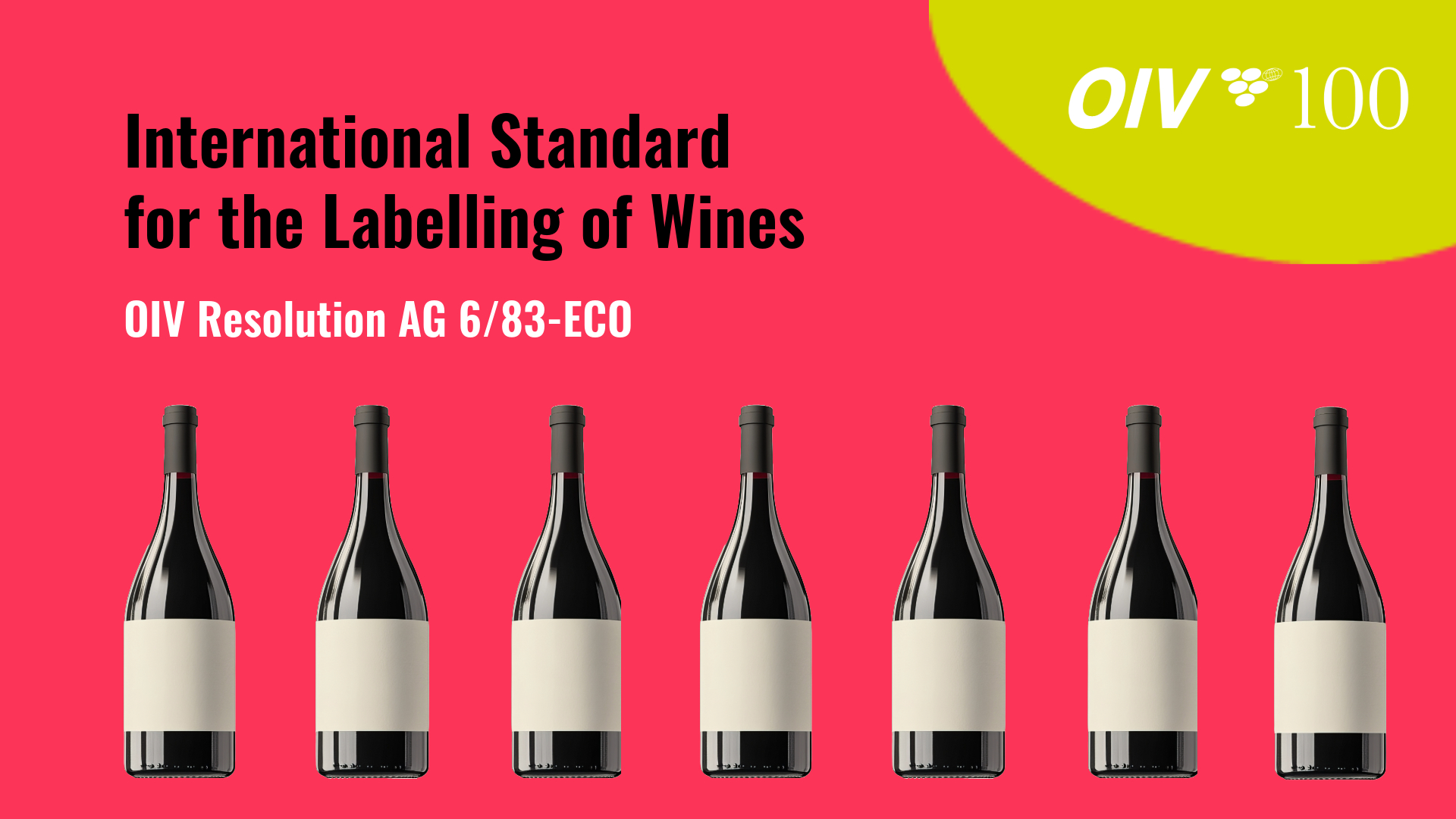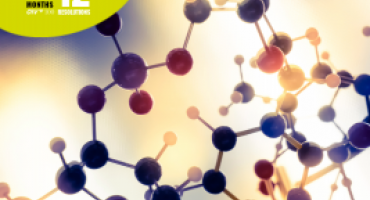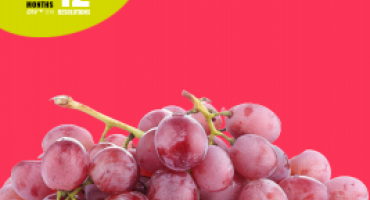Este mes, analizamos una resolución que sentó las bases de las primeras disposiciones generales sobre el etiquetado de los vinos y que marcó un hito en la lucha contra la falsificación de estos productos: la Resolución AG 6/83-ECO, adoptada en 1983.


El etiquetado en los textos fundacionales de la OIV
La regulación del etiquetado es clave para la Organización Internacional de la Viña y el Vino (OIV). Desde la fundación de la OIV en 1924, el sector vitivinícola ha debido enfrentar diversas adversidades, como una sobreproducción difícil de controlar, los constantes fraudes, los altos impuestos, la expansión de políticas prohibicionistas y la recuperación de los viñedos tras la crisis de la filoxera. En este contexto, el etiquetado ha desempeñado un papel clave al garantizar la transparencia de los productos y la protección de los consumidores.
Uno de los objetivos del Acuerdo de 20011 es la armonización internacional de las normas existentes y, en caso necesario, la elaboración de nuevas normas internacionales. Para alcanzar estos objetivos, la OIV elabora recomendaciones relativas a la definición y/o descripción de productos, etiquetado y condiciones de puesta en el mercado2.
Una de las prioridades de la OIV es garantizar la autenticidad del vino, proteger a los consumidores y defender los derechos de propiedad intelectual. Estas preocupaciones llevaron a la adopción de la primera resolución destinada a establecer una Norma Internacional para el etiquetado de los vinos.
Primera resolución sobre etiquetado de los vinos y primera Norma Internacional para el etiquetado de los vinos de la OIV
La Resolución AG 6/83-ECO3, adoptada en 1983, estableció las primeras disposiciones generales sobre el etiquetado de los vinos, como definiciones, indicaciones obligatorias sobre la denominación del producto y la indicación del grado alcohólico. Esta resolución significó un gran avance en la lucha contra la falsificación de productos al introducir menciones obligatorias que garantizan la autenticidad del vino.
Ampliación y desarrollo de la Norma Internacional para el etiquetado de los vinos
En 19854, la OIV amplió esta norma al adoptar nuevas menciones obligatorias, como el país de origen, el volumen nominal y la dirección del responsable del preenvasado. En 19885, estas disposiciones se complementaron con indicaciones facultativas.
Por otra parte, cabe destacar que la armonización de la información sobre el origen geográfico de los vinos ha supuesto un gran desafío. Ya en 19476, la OIV había adoptado una definición de denominación de origen. En 1992, estos avances se actualizaron e incorporaron en la Norma Internacional para el etiquetado de los vinos7.
A lo largo de los años, la OIV ha actualizado sus recomendaciones para adaptarse a los cambios del sector, incluyendo aspectos como la determinación de los azúcares8, la indicación de sulfitos9, las disposiciones sobre los idiomas10 y la legibilidad de las etiquetas11. De esta manera, tanto las menciones facultativas como las obligatorias han sido revisadas regularmente para garantizar una mayor protección del consumidor.
Evolución de la Norma Internacional para el etiquetado de los vinos: armonización con el Codex Alimentarius
En 2017, el Comité Ejecutivo de la OIV (COMEX) encomendó al Grupo de expertos “Derechos e Información al Consumidor” (DROCON) la revisión de la Norma Internacional para el etiquetado de los vinos. El principal objetivo era alinearla con las disposiciones del Codex Alimentarius, en particular por lo que respecta a la Norma General para el Etiquetado de los Alimentos Preenvasados (CODEX STAN 1-1985) y las Directrices del Codex sobre Etiquetado Nutricional (CAC/GL 2-1985).
A lo largo de siete años, el grupo de expertos DROCON elaboró y adoptó diez resoluciones que actualizan esta norma. Entre las modificaciones realizadas, cabe señalar cambios en las menciones obligatorias, tales como la revisión de las disposiciones sobre la indicación del grado alcohólico12, información sobre residuos alergénicos13 y definiciones de indicación geográfica y denominación de origen14. Además, se actualizaron las menciones facultativas, que ahora incluyen aquellas referidas a medallas y distinciones15, el nombre de la explotación vitícola16, indicaciones sobre el envejecimiento del vino17, la añada o año de cosecha18 y el nombre de la variedad de vid19.
Incorporación del etiquetado electrónico y la información nutricional: la Resolución OIV-ECO 676-2024
Un hito importante de esta revisión fue la adopción de la Resolución OIV-ECO 676-202420 en octubre de 2024. Tras siete años de debates y trabajo, se alcanzó un consenso para incluir el etiquetado electrónico, la declaración de nutrientes y la lista de ingredientes en la Norma Internacional para el etiquetado de los vinos.
Perspectivas de ampliación de la revisión de la norma de etiquetado a otros productos vitivinícolas
En 2017, el mandato del Comité Ejecutivo de la OIV allanó el camino para una reforma más ambiciosa del etiquetado de los productos vitivinícolas, en respuesta a los cambios del sector y a las expectativas de los consumidores. Esta revisión permite ahora trasladar el debate sobre el vino a las bebidas espirituosas de origen vitivinícola (BOISPI). En este sentido, el Grupo de expertos BOISPI trabaja actualmente en la revisión de la Norma Internacional para el etiquetado de estos productos, tomando como referencia directa los trabajos realizados por el Grupo DROCON.
1 Artículo 2, párrafo 1 c) del Acuerdo del 3 de abril de 2001 por el que se crea la Organización Internacional de la Viña y el Vino
2 Artículo 2, párrafo 2 b) iii del Acuerdo de 3 de abril de 2001 por el que se crea la Organización Internacional de la Viña y el Vino
3 Resolución AG 6/83-ECO, Información y formación del consumidor
4 Resolución AG 5/85-ECO, Norma para el etiquetado de vinos: indicaciones engañosas, volumen nominal, país de origen, nombre y dirección del responsable del preenvasado.
5 Resolución ECO 1/88, Norma para el etiquetado de vinos: menciones optativas
6 Resolución AG 1/47-ECO, Definición de denominación de origen
7 Resolución ECO 2/92, Indicación geográfica reconocida, denominación de origen reconocida (definiciones)
8 Resolución ECO 3/2003, Determinación de los azúcares
9 Resolución ECO 1/2003, Norma Internacional de la OIV para el etiquetado de los vinos: indicación de sulfitos
10 Resolución ECO 1/2006, Armonización del etiquetado de los vinos – idioma
11 Resolución ECO 2/2006, Armonización del etiquetado de los vinos – legibilidad
12 Resolución OIV-ECO 649-2020, Actualización de la Norma Internacional para el etiquetado del vino: indicación del grado alcohólico y métodos de control del volumen nominal
13 Resolución OIV-ECO 648-2020, Actualización de la Norma Internacional para el etiquetado de los vinos por lo que respecta al etiquetado de los aditivos y residuos potencialmente alergénicos
14 Resolución OIV-ECO 656-2021, Actualización de las definiciones de indicación geográfica y denominación de origen
15 Resolución OIV-ECO 685-2022, Actualización de la Norma Internacional para el etiquetado de los vinos: Medallas y distinciones
16 Resolución OIV-ECO 700-2023, Actualización de la Norma Internacional para el etiquetado de los vinos: Nombre de la explotación vitícola
17 Resolución OIV-ECO 698-2023, Actualización de la Norma Internacional para el etiquetado de los vinos: Envejecimiento del vino
18 Resolución OIV-ECO 697-2023, Actualización de la Norma Internacional para el etiquetado de los vinos: Añada o año de cosecha
19 Resolución OIV-ECO 696-2024, Actualización de la Norma Internacional para el etiquetado de los vinos: Nombre de la variedad de vid
20 Resolución OIV-ECO 676-2024, Actualización de la Norma Internacional para el etiquetado de los vinos de la OIV: Etiqueta electrónica, declaración de nutrientes y lista de ingredientes.


